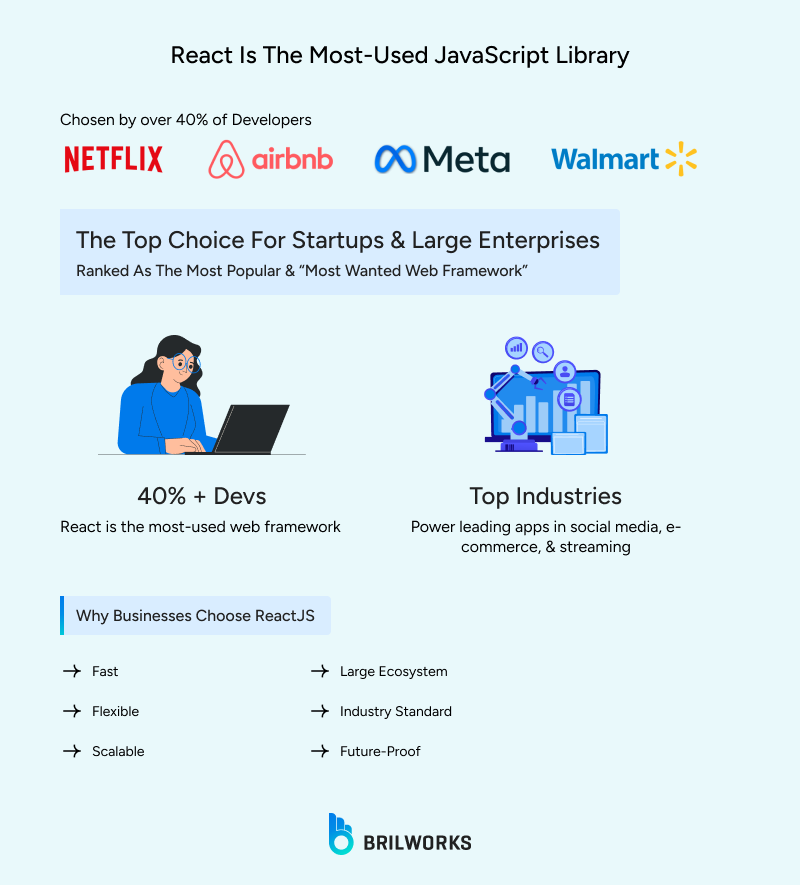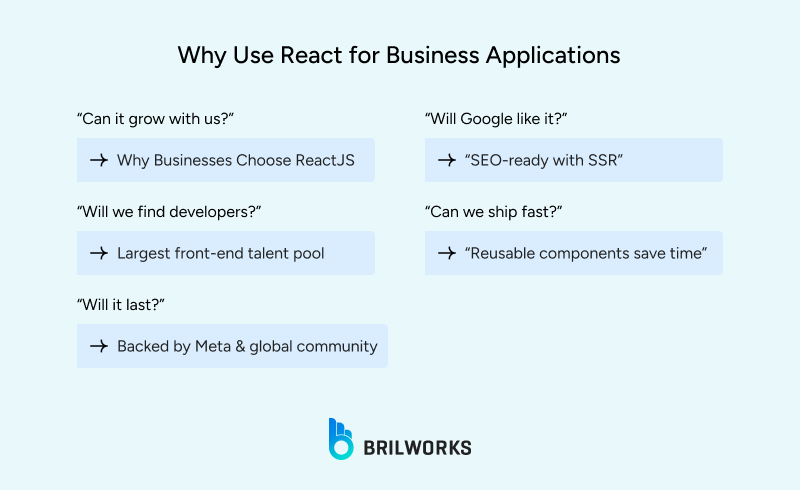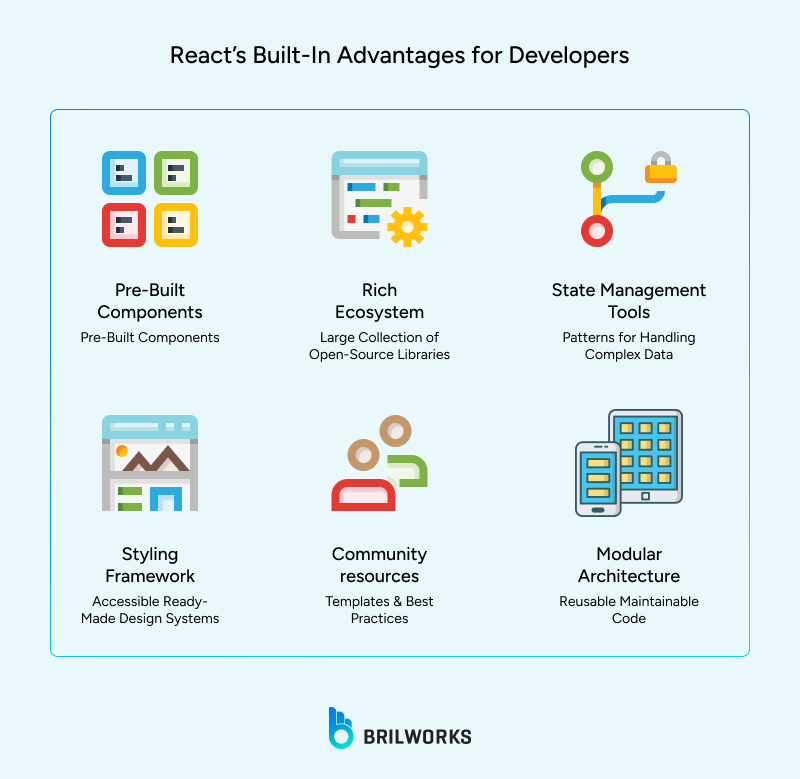COOPERATION MODEL
ARTIFICIAL INTELLIGENCE
PRODUCT ENGINEERING
DevOps & Cloud
LOW-CODE/NO-CODE DEVELOPMENT
INDUSTRY
FRONTEND DEVELOPMENT
CLOUD DEVELOPMENT
MOBILE APP DEVELOPMENT
LOW CODE/ NO CODE DEVELOPMENT
EMERGING TECHNOLOGIES








React has become one of the most dominant web technologies in contemporary web development. The React and Node combination is very common today. From Netflix and Facebook to Airbnb and Instagram, ReactJS has been one of the core components in the tech stacks of millions of companies of all sizes worldwide. Developed by a team at Facebook (now Meta), this open-source library features a component-based architecture, providing a great level of flexibility for developers to build complex web UIs.
It is mainly used to build dynamic user interfaces, also known as interactive user interfaces (UIs). The reason is that they are called interactive because they include components that can change their state as per the user’s interaction. Have you ever observed Facebook and Instagram’s like button? When you tap on it, it changes its state without a full page reload. React is one of the most sought-after front end technologies for crafting such kinds of user interfaces or components.
It is used for building admin panels, dashboards, single-page applications such as a social platform, interfaces with real-time features, progressive web apps, and so on. Given that it runs on JavaScript, finding or hiring ReactJS experts/developers is shorter and less painful.
In case you don’t want to set up a development environment from scratch and plan to outsource website UI development services, you are in the right place. In this article, we will guide you on ReactJS development, how to find an expert React company, and the cost of building a web application with ReactJS.
In the first place, it may sound contradictory, yet even with React’s popularity, businesses often face a difficult challenge: finding React.JS developers or service providers. With countless firms claiming expertise, it is often a tightrope walk to identify which React JS development company genuinely has the hands-on expertise to deliver what you want to build. Well, in this guide, we will try to answer these questions.
Plus, we’ll break down everything you should know before onboarding React development agency.
The idea behind ReactJS development was simple: instead of writing one big program, React provided a framework where developers could break development into small parts or phases. Then combine these parts together to build an entire application. In the tech industry, this approach is known as modular development. According to recent industry figures, around 85% of large enterprises now use microservices architectures, which include modular principles.
Real-time, single-page applications include complex logic and are heavy in size; for this reason, developers often prefer breaking down the application into manageable modules (or components).
This modular approach is not unique to React, as React is powered by JavaScript, a widely used language, and it benefits from a large pool of developers. This means hiring costs are often lower compared to more niche technologies. That makes it an attractive choice for startups with smaller budgets that still want to build something innovative, modern, and fast, without risking architectural lock-in. Over time, they can also evolve the product with the help of React’s active community. Plus, the library runs across different browsers.

When companies plan a new digital product, the choice of technology is always a big question. Many managers ask, “Why use React when we already have so many frameworks available?” The reason lies less in code details and more in business outcomes.

First, React supports fast and stable growth. A startup may begin with a simple web app, but as the user base grows, the same code can scale without a full rebuild. This is one reason companies like Netflix and Shopify continue to trust React for large systems. It allows them to move from thousands to millions of users without major disruption. Another reason is developer availability.
According to the 2024 Stack Overflow survey, React is the most commonly used front-end library worldwide. For a business, this means hiring React developers is easier, faster, and often less expensive compared to other technologies.
SEO is also an important part of this decision. Many business websites depend on visibility in search engines. React works well with modern techniques like server-side rendering, which helps content appear faster to both users and Google. Better performance often translates into better rankings and more traffic.
Lastly, React makes teams more productive. Components that are built once can be reused again, reducing delivery time. In business terms, this means quicker releases, faster customer feedback, and shorter time-to-market.

Let's take a brief look at React vs other popular frameworks, such as Angular and Vue. When planning a digital product, many companies compare React with other popular frameworks like Angular and Vue. Each option has strengths, but the decision often depends on scale, team skills, and long-term goals. This is why understanding the differences is important before choosing a partner or investing in a project.

Angular is a full framework created by Google. It provides everything out of the box: routing, state management, and strict rules on how to structure code. Some enterprises prefer Angular because of this structure. It reduces the chance of teams going in different directions.
But it also comes with a steep learning curve. React, by contrast, is more flexible. It is often called a “library” rather than a full framework. Businesses like this flexibility because they can add only the tools they need, without being locked into one style. A 2024 JetBrains survey showed that developers rated React easier to adopt compared to Angular, especially for smaller and mid-sized teams.
Vue is another fast-growing option. Many developers enjoy its simplicity and gentle learning curve. Startups with small teams often pick Vue because they can move quickly at the beginning. But Vue still has a smaller ecosystem compared to React. For businesses, this means fewer ready-made libraries, less global talent, and sometimes slower hiring.
According to npm trends 2024, React downloads are about five times higher than Vue, showing its larger adoption in real-world projects.
The strength of React is not only technical but also strategic. React JS itself stands out because of its wide adoption, community support, and talent availability. It works best when:
A business needs an application that can scale from a simple MVP to millions of users.
Teams want freedom to choose their own tools instead of following one strict framework.
Hiring speed and availability of developers are priorities.
React services include many types of work that can support a business at different stages of a project. These services are not only about building a new website or app. They can also help improve an existing product, update old technology, or connect different systems to work together.
If you know what kinds of React services are available, it becomes easier to choose the right one for your needs. For example, a company may need a custom React app built from the ground up, or they might only need help moving their current app to React. Both are React services, but they solve different problems.

This service covers building applications designed to match a business’s specific needs. It uses the flexibility of React to create features, layouts, and workflows that work well for the intended audience and business goals.
This involves moving an existing website or application to React. It is often done to improve speed, maintainability, or to take advantage of the larger React ecosystem without changing the core business logic.
Part of React services also includes designing how the application looks and feels. This ensures the interface is clear, easy to use, and consistent across different devices.
This connects a React application to other systems, such as databases, third-party tools, or internal software. It allows the application to share and update information in real time.
React can be used to build online stores that handle product catalogs, shopping carts, and secure checkouts, offering a smooth buying experience for customers.
For businesses offering software as a service, React helps create scalable, user-friendly platforms that work in browsers without requiring installation.
React services also include building dashboards that show data, reports, and analytics in a clear format, making it easier for teams to make decisions.
These applications adjust automatically to different screen sizes, allowing users to access them comfortably on phones, tablets, and desktops.
After an application is launched, React services can cover fixing errors and keeping the code up to date with the latest practices.
This focuses on making the application faster and more efficient so it runs smoothly even with heavy traffic or large datasets.
Part of ongoing maintenance includes applying updates that protect the application from security risks.
React services may also involve adding new features over time to keep the application relevant and useful for its users.
Not every company that works with React will be the right fit for every project. A strong partner is one that can map business requirements into a clear React architecture before writing a single line of code. This is often visible in how they discuss your needs during early talks, whether they focus only on features or also explore user flows, integration points, and long-term maintenance.
Portfolios can be misleading if judged only by design. What matters more is the context behind the work. For example, did the team reduce page load time for a high-traffic app? Did they migrate a complex legacy system without downtime? These are the kinds of results that point to real capability.
Warning signs often appear early. A partner who gives a fixed cost and delivery date without a discovery phase may be working on guesswork. Teams that avoid explaining their testing process or skip discussing how they handle production issues may not be prepared for real-world demands.
The best fit is rarely the fastest or cheapest offer, it’s the one that shows a working method for turning business challenges into dependable, scalable React solutions.
In any React project, the process matters as much as the technology. A good end product isn’t the result of chance, it comes from a structured approach that reduces risk, surfaces problems early, and keeps the build aligned with business goals.
Over time, certain steps have proven critical: setting a clear direction before coding, designing with reusability in mind, testing under real-world conditions, and maintaining the product after launch. The outline below explains what each phase involves so there are no surprises, whether the project is a small MVP or a full enterprise platform.
We start by learning what the business needs. This means talking to the people who will use the product and checking how it will connect with other systems. We then plan the structure of the app. At this stage, risks are spotted early so they can be solved before coding starts.
The design shows how the app will look and work. Simple drafts or clickable models help confirm ideas. Then, we build in short steps. After each step, progress is shown so feedback can be added quickly.
Testing checks if the app works well on all devices. It also looks for speed and security issues. Deployment moves the app to live use, with monitoring to catch any problems.
After launch, we watch how real users interact with the app. Small fixes, updates, and improvements are made to keep it fast, secure, and ready for growth.
Cost is often the first question in any React project discussion, and for good reason, it shapes what can be built, how quickly it can launch, and which team is the right fit. Many businesses misjudge budgets by relying on outdated figures or estimates that ignore key variables like region, engagement model, or app complexity.
Understanding the current market rates and the factors that influence them helps set realistic expectations and prevents costly scope changes later.
Freelancers typically charge $20–$100/hour, especially across regions with lower cost of living
Established agencies or structured teams often bill $50–$200/hour, reflecting added project management and alignment capabilities
In-house hiring includes overhead costs and salary commitments, making it viable only for long-term, tightly controlled roadmaps.
North America: ~$50–150/hr, mid-level developers often $70–90/hr, seniors $90–150/hr
Western Europe: ~$30–100/hr depending on country and experience
Eastern Europe: ~$20–60/hr, with mid-level developers ~$35–50/hr
Asia (India, Vietnam, Philippines): ~$15–50/hr; seniors at ~$45–70/hr in trusted markets
Latin America: ~$25–70/hr, often matching U.S. time zones for collaboration ease
Simple React web app: ~200–500 hours, total cost $5K–$30K
Moderate complexity: ~800–1,500 hours, cost ranges $30K–$60K+
Enterprise/high-complexity apps: 1,500+ hours, budgets often $70K–150K+
Seniority & specialization: Mid‑level vs. senior React devs differ significantly in rates; adding skills in Redux, GraphQL, Next.js, TypeScript typically adds 15–35% premium.
Engagement type: Fixed‑price contracts typically include buffers; hourly or time‑and‑materials models offer flexibility but need strict scope control
Project duration & support needs: Ongoing maintenance, updates, and enhancements can add roughly 15–20% of annual development budget
Market trends: Offshore rates in Eastern Europe and South Asia have declined ~9–16% recently due to increased AI and automation productivity
|
Level / App Type |
Region |
Developer Rate/hr |
Estimated Total Cost |
|
Simple UI app |
Asia (mid-level) |
~$30 |
~$10K–$15K |
|
Moderate complexity app |
Eastern Europe |
~$45 |
~$30K–$60K |
|
High-complexity enterprise app |
North America |
~$100 |
$70K–$150K+ |
Brilworks examines how the React ecosystem is changing. While React remains dominant, used in over 82 million websites and nearly 43% of top sites, it faces fresh competition from lighter frameworks like Svelte, SolidJS, and Vue, which offer cleaner syntax and performance benefits.
They also note growing complexity in React projects: working with Redux, concurrent features, and evolving architectures is no longer straightforward. According to Mark Erikson, the Redux lead, the ecosystem now feels “complicated”—no longer simple by default. This shift requires businesses to rethink how they plan and maintain React-based products.
React retains a massive install base and an active community, but enterprises must account for rising complexity. Modern features, like concurrent mode, server components, and streaming, offer performance advantages but demand deeper expertise.
Meanwhile, challengers such as Svelte and SolidJS attract attention by delivering faster performance and smaller bundles. Choosing React now means planning for architectural decisions that may evolve significantly within a few years and ensuring the right skillsets are in place.
Planning ahead means more than just writing code; it’s about ensuring scalability. Reactive data flows, code splitting, and server-side rendering (SSR) help future-proof applications.
Mapping a technology roadmap upfront, deciding when to adopt features like React Server Components or migrating to emerging state management tools, lets businesses avoid rework. Continuous improvement through performance audits, modular refactoring, and code reviews ensures the application stays stable and responsive as it scales.
React's popularity continues to expand and it is a smart choice for many companies, but the software's increasing complexity means that success requires a willingness to prioritize and think ahead. Emerging capabilities offer new potential for user experience and performance but build new architectural options, confusion and new risk.
If you are planning a migration, exploring new React features, or dealing with rapid growth in your organization, we can help you get there. Brilworks has an experienced team of dedicated ReactJS developers with the expertise to build scalable solutions but also our ReactJS development service capabilities span from architecture reviews, to performance optimization. So, whether you are required ReactJS migration experts, or a ReactJS development team, we can create a new solution that is geared towards your long term goals.
Get In Touch
Contact us for your software development requirements
Get In Touch
Contact us for your software development requirements